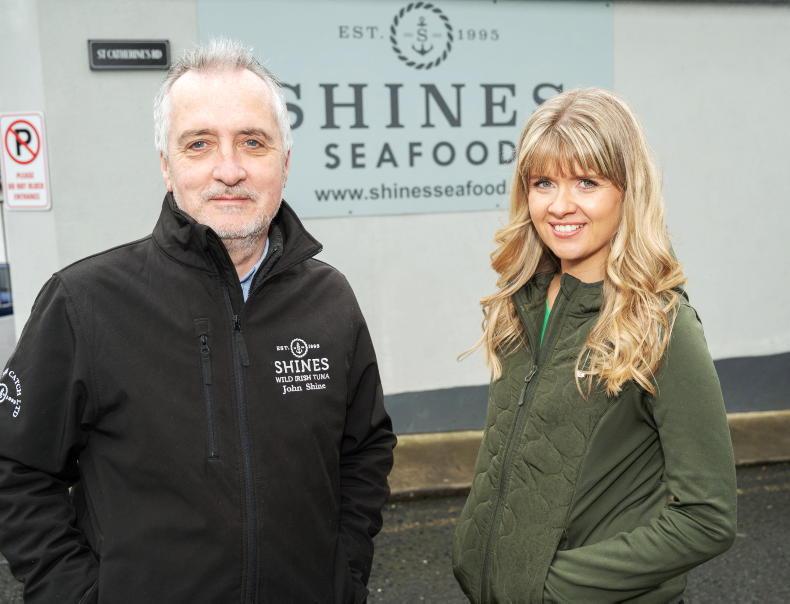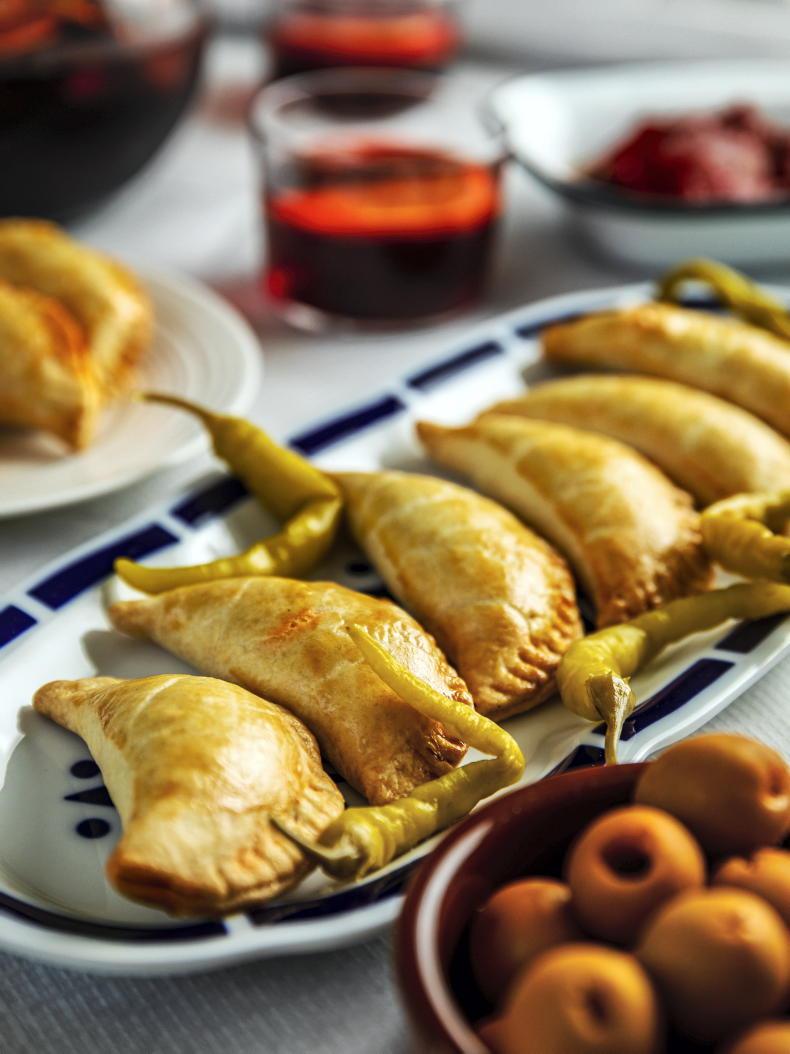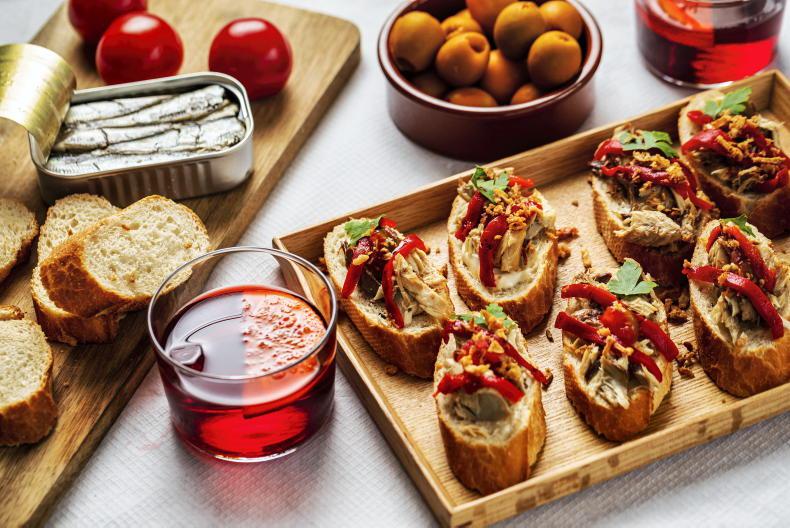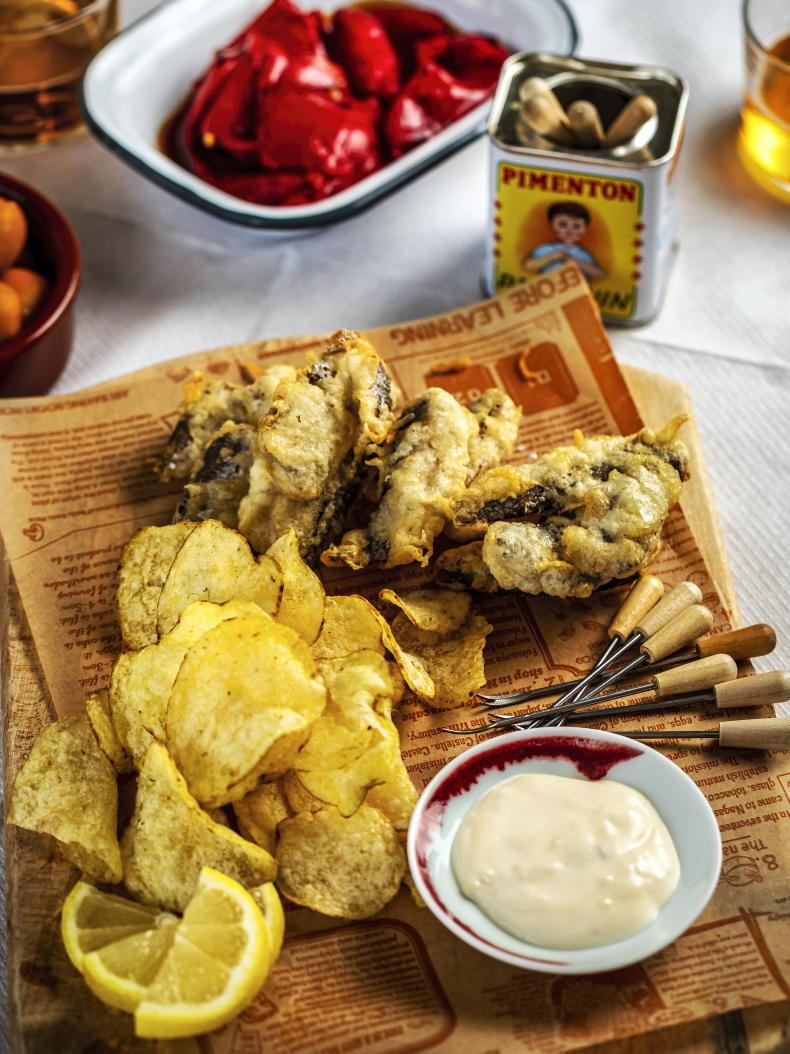The sustainability around seafood and seafood products can be a tricky space to navigate, even for the savviest consumer. We all enjoy a good tuna salad sandwich every now and then, but when it comes to tinned fish, the sustainability can be even more confusing with mainly international brands dominating supermarket shelf space.
I avoided tinned fish, like tuna, until I started to see an Irish brand on the shelf. Now, I couldn’t go back to the international brands even if I wanted to, because the quality of Shine’s Seafood is excellent.

Ciara and John Shine \ Clive Wasson.
Irish Country Living recently spoke with father-daughter duo Ciara and John Shine, who operate the family-run business in Killybegs, Co Donegal together.
“Dad was from Dublin and mum [Marianne] grew up in England but had connections to Killybegs,” Ciara says. “When mum moved here, she met my dad on the very same day. It was just meant to be.”
Hatching a plan
Marianne and John previously owned a fish shop and over the years – being so close to the fishing industry in Killybegs – got to know plenty of local fishermen and women. Ciara says they used to holiday in Basque country, in northern Spain, and one day she asked her father why they couldn’t get the type of tuna (preserved in larger pieces in olive oil) in Ireland that they enjoyed so often in Spain. A plan was soon hatched to achieve this quality, using Irish-caught, wild albacore tuna.
“We thought at first that even if we didn’t sell any, we could at least keep the tuna for ourselves to eat,” laughs Ciara. “But then we got involved in the [SuperValu] Food Academy and we realised there was a market for it.”

Father and daughter, Ciara and John Shine, live in Killybegs where they operate Shine's Seafood \ Clive Wasson.
Since those first early days in business, the Shine’s Seafood line has grown from a selection of wild tuna products (available tinned or in glass jars, either in spring water or preserved in olive oil), preserved, tinned Irish-caught sardines and preserved, tinned winter-caught mackerel.
They are now available throughout Ireland at most major retailers and in independent food shops.
“We only use winter-caught mackerel,” Ciara explains. “It has a really distinctive buttery taste thanks to its higher omega-3 content.
“People would rate it quite highly. Everything is wild, all of our albacore tuna and sardines are Irish-caught and we have approval from the FSAI [Food Safety Authority of Ireland], Bord Bia and BIM [Bord Iascaigh Mhara], so anything we say is Irish is definitely Irish, caught by Irish men and women, under the Irish quota and in Irish waters.”
The fishing vessels they work with take ocean conservation seriously; adhering strictly to their quotas and only fishing during the allocated time of year (the season for albacore tuna, for example, is August and September of each year).
Shine’s Seafood advocates for improving net technology which helps eliminate by-catch (unintended fish being caught in tuna nets). Boats also use pingers to keep dolphins safely away from their nets.
To continue with this issue of ICL Food’s northern Spanish theme, we asked Spanish food writer and expert, Blanca Valenica, to share some of her favourite Spanish-inspired recipes for tinned fish.
Why tinned?
Preserving fish is an ideal way to create a shelf-stable, nutritious seafood product which packs in loads of flavour.
Particularly enjoyed in places like Spain and Portugal, tinned sardines come preserved in a variety of sauces and can be eaten straight out of the tin. That said, there are many ways to enjoy tinned fish (aside from the classic tuna salad).
Tuna and Harissa Empanadas
A lovely portable food for a picnic or packed lunch. Harissa is a fiery chiili paste from north Africa which enhances the tuna perfectly.

\ Philip Doyle
100g sofrito (see recipe below)
1 Tbsp harissa paste
125g Shine’s Irish tuna
Salt and pepper, to taste
Flour, for dusting
320g store-bought shortcrust pastry
1 egg, beaten

\ Philip Doyle
1 Leave the shortcrust pastry out of the fridge for at least 30 minutes so the dough is pliable and easy to work with.
2 Preheat the oven to 180°C. Line a baking tray with parchment paper and set aside until ready to use.
3 In a bowl, mix the tuna with the sofrito and harissa. Season with salt and pepper to taste. Lightly dust your work surface with flour and roll out the dough thinly until you can cut out eight 10cm circles.
4 Once the eight circles are cut from the dough, gather the leftover pastry. Roll it out again to a similar thickness and cut two more 10cm diameter circles. Once finished, you should have a total of 10 pastry circles. Place them on the baking sheet or on a clean work surface and place a tablespoon of the tuna filling on each one (position the filling to one side to make the next step easier).
5 Prepare a small bowl of water for sealing the empanadas. Take one empanada, place your finger in the water and run the water around the edges. Fold the dough over the filling and press the edges together; creating a half moon. Place the sealed empanada on the baking tray and continue this process with each of the remaining empanadas.
6 When all of the empanadas are formed and sealed, use a fork to press down on the edges – just to make sure it is completely sealed (it looks really nice, too).
7 Brush each empanada with the beaten egg and bake for approximately 15 to 20 minutes in the preheated oven, until golden brown. Serve warm or at room temperature with olives, pickled peppers and chilled wine or beer. These will keep in the fridge for up to four days and they are delicious as a room temperature snack.
This is the base of all Spanish dishes – from paella to stews and everything in between.
5 tbsp olive oil
1 small yellow onion, diced
1 green or red pepper, diced
2 garlic cloves, minced
400g tin tomatoes, or 5–6 fresh tomatoes, diced
Salt and pepper to taste
1 Heat the olive oil in a large sauté pan over medium heat. Sauté the onions until they are translucent, about seven minutes.
2 Add the peppers and garlic and stir. Add the tomatoes and cook for 15 minutes, stirring frequently or until the tomatoes have softened and the consistency has thickened.
3 Season with salt and pepper to taste. This can be stored in the fridge for up to four days.
Mackerel crostini with piquillo pepper
Piquillo peppers are sweet chillis, mainly grown in the Basque country in Spain. The name comes from the Spanish for “little beak”, referring to their shape. You’ll often find them paired with seafood in Basque pintxos bars.

Mackerel crostini with piquillo pepper \ Philip Doyle
10 slices of toasted baguette
2 tbsp mayonnaise
125g Shine’s mackerel
3 piquillo peppers, sliced thinly
3 tbsp storebought crispy onions
10 parsley leaves, for garnish

Mackerel crostini with piquillo pepper \ Philip Doyle
1 Put the toasted bread on a platter and spread each slice with a little bit of mayonnaise. Divide the mackerel evenly among the crostini. Decorate with the sliced piquillo peppers, crispy onions and parsley leaves.
2 Serve warm or at room temperature with beer or chilled white wine. This is best eaten directly after preparing and is best prepared fresh.
Wild sardine tempura with
lemon aioli and crisps
These tempura sardines hit the spot when you are craving fish and chips, and the preserved lemon in the aioli is the perfect punchy pairing.

\ Philip Doyle
For the aioli
¼ cup of mayonnaise
1 clove of garlic, crushed
1 tsp lemon juice
2 tsp preserved lemon, finely chopped
For the tempura
118g tin Shine’s wild sardines in olive oil
50g of storebought tempura batter mix
80ml of water
Sunflower oil, for frying
1 bag of plain salted potato crisps
½ lemon, cut into wedges

\ Philip Doyle
1 In a bowl, mix the aioli ingredients together and refrigerate until ready to serve.
2 Open the tin of sardines and carefully drain the oil (the oil can be saved for a salad dressing, if you like).
3 Using a knife, carefully separate the sardines lengthways in half. If they break, don’t worry – they will still fry up nicely and taste great.
4 Mix the tempura batter mix with the water and whisk. If it seems too thick you can add a bit more water. It should be light, but still coat the fish nicely.
5 Place a piece of kitchen towel on a large plate and set the plate next to your stove top. Add the oil into a heavy bottomed pot (with sufficient depth for frying) or a heavy cast iron pan. Heat the oil to 180°C. Test the oil with a little piece of bread to make sure it’s hot enough.
6 Working quickly, dip each sardine individually into the batter mix and carefully add to the hot oil. Don’t worry if the sardines break up a little bit.
7 Fry in batches of four or five sardines (do not crowd the pan). It will take approximately one to two minutes for the fish to fry. Remove the sardines from the oil when the batter looks crisp and slightly golden.
8 Place the fried sardines on the plate lined with paper to absorb any excess oil. Season with a bit of salt while the fish is really hot.
9 Continue frying the sardines in batches of four or five until all of the sardines are used.
10 Serve hot with the preserved lemon aioli, wedges of lemon and potato chips over parchment paper (don’t forget the beer!).
Win a hamper full of Shine’s Seafood products by answering this question:
What species of tuna is fished in Ireland?
Email your response to ICL@farmersjournal.ie to be in for a chance to win.
Read more
Salmon of Knowledge: what is happening to our wild salmon population?
Meet the lads in the Lifeboat
The sustainability around seafood and seafood products can be a tricky space to navigate, even for the savviest consumer. We all enjoy a good tuna salad sandwich every now and then, but when it comes to tinned fish, the sustainability can be even more confusing with mainly international brands dominating supermarket shelf space.
I avoided tinned fish, like tuna, until I started to see an Irish brand on the shelf. Now, I couldn’t go back to the international brands even if I wanted to, because the quality of Shine’s Seafood is excellent.

Ciara and John Shine \ Clive Wasson.
Irish Country Living recently spoke with father-daughter duo Ciara and John Shine, who operate the family-run business in Killybegs, Co Donegal together.
“Dad was from Dublin and mum [Marianne] grew up in England but had connections to Killybegs,” Ciara says. “When mum moved here, she met my dad on the very same day. It was just meant to be.”
Hatching a plan
Marianne and John previously owned a fish shop and over the years – being so close to the fishing industry in Killybegs – got to know plenty of local fishermen and women. Ciara says they used to holiday in Basque country, in northern Spain, and one day she asked her father why they couldn’t get the type of tuna (preserved in larger pieces in olive oil) in Ireland that they enjoyed so often in Spain. A plan was soon hatched to achieve this quality, using Irish-caught, wild albacore tuna.
“We thought at first that even if we didn’t sell any, we could at least keep the tuna for ourselves to eat,” laughs Ciara. “But then we got involved in the [SuperValu] Food Academy and we realised there was a market for it.”

Father and daughter, Ciara and John Shine, live in Killybegs where they operate Shine's Seafood \ Clive Wasson.
Since those first early days in business, the Shine’s Seafood line has grown from a selection of wild tuna products (available tinned or in glass jars, either in spring water or preserved in olive oil), preserved, tinned Irish-caught sardines and preserved, tinned winter-caught mackerel.
They are now available throughout Ireland at most major retailers and in independent food shops.
“We only use winter-caught mackerel,” Ciara explains. “It has a really distinctive buttery taste thanks to its higher omega-3 content.
“People would rate it quite highly. Everything is wild, all of our albacore tuna and sardines are Irish-caught and we have approval from the FSAI [Food Safety Authority of Ireland], Bord Bia and BIM [Bord Iascaigh Mhara], so anything we say is Irish is definitely Irish, caught by Irish men and women, under the Irish quota and in Irish waters.”
The fishing vessels they work with take ocean conservation seriously; adhering strictly to their quotas and only fishing during the allocated time of year (the season for albacore tuna, for example, is August and September of each year).
Shine’s Seafood advocates for improving net technology which helps eliminate by-catch (unintended fish being caught in tuna nets). Boats also use pingers to keep dolphins safely away from their nets.
To continue with this issue of ICL Food’s northern Spanish theme, we asked Spanish food writer and expert, Blanca Valenica, to share some of her favourite Spanish-inspired recipes for tinned fish.
Why tinned?
Preserving fish is an ideal way to create a shelf-stable, nutritious seafood product which packs in loads of flavour.
Particularly enjoyed in places like Spain and Portugal, tinned sardines come preserved in a variety of sauces and can be eaten straight out of the tin. That said, there are many ways to enjoy tinned fish (aside from the classic tuna salad).
Tuna and Harissa Empanadas
A lovely portable food for a picnic or packed lunch. Harissa is a fiery chiili paste from north Africa which enhances the tuna perfectly.

\ Philip Doyle
100g sofrito (see recipe below)
1 Tbsp harissa paste
125g Shine’s Irish tuna
Salt and pepper, to taste
Flour, for dusting
320g store-bought shortcrust pastry
1 egg, beaten

\ Philip Doyle
1 Leave the shortcrust pastry out of the fridge for at least 30 minutes so the dough is pliable and easy to work with.
2 Preheat the oven to 180°C. Line a baking tray with parchment paper and set aside until ready to use.
3 In a bowl, mix the tuna with the sofrito and harissa. Season with salt and pepper to taste. Lightly dust your work surface with flour and roll out the dough thinly until you can cut out eight 10cm circles.
4 Once the eight circles are cut from the dough, gather the leftover pastry. Roll it out again to a similar thickness and cut two more 10cm diameter circles. Once finished, you should have a total of 10 pastry circles. Place them on the baking sheet or on a clean work surface and place a tablespoon of the tuna filling on each one (position the filling to one side to make the next step easier).
5 Prepare a small bowl of water for sealing the empanadas. Take one empanada, place your finger in the water and run the water around the edges. Fold the dough over the filling and press the edges together; creating a half moon. Place the sealed empanada on the baking tray and continue this process with each of the remaining empanadas.
6 When all of the empanadas are formed and sealed, use a fork to press down on the edges – just to make sure it is completely sealed (it looks really nice, too).
7 Brush each empanada with the beaten egg and bake for approximately 15 to 20 minutes in the preheated oven, until golden brown. Serve warm or at room temperature with olives, pickled peppers and chilled wine or beer. These will keep in the fridge for up to four days and they are delicious as a room temperature snack.
This is the base of all Spanish dishes – from paella to stews and everything in between.
5 tbsp olive oil
1 small yellow onion, diced
1 green or red pepper, diced
2 garlic cloves, minced
400g tin tomatoes, or 5–6 fresh tomatoes, diced
Salt and pepper to taste
1 Heat the olive oil in a large sauté pan over medium heat. Sauté the onions until they are translucent, about seven minutes.
2 Add the peppers and garlic and stir. Add the tomatoes and cook for 15 minutes, stirring frequently or until the tomatoes have softened and the consistency has thickened.
3 Season with salt and pepper to taste. This can be stored in the fridge for up to four days.
Mackerel crostini with piquillo pepper
Piquillo peppers are sweet chillis, mainly grown in the Basque country in Spain. The name comes from the Spanish for “little beak”, referring to their shape. You’ll often find them paired with seafood in Basque pintxos bars.

Mackerel crostini with piquillo pepper \ Philip Doyle
10 slices of toasted baguette
2 tbsp mayonnaise
125g Shine’s mackerel
3 piquillo peppers, sliced thinly
3 tbsp storebought crispy onions
10 parsley leaves, for garnish

Mackerel crostini with piquillo pepper \ Philip Doyle
1 Put the toasted bread on a platter and spread each slice with a little bit of mayonnaise. Divide the mackerel evenly among the crostini. Decorate with the sliced piquillo peppers, crispy onions and parsley leaves.
2 Serve warm or at room temperature with beer or chilled white wine. This is best eaten directly after preparing and is best prepared fresh.
Wild sardine tempura with
lemon aioli and crisps
These tempura sardines hit the spot when you are craving fish and chips, and the preserved lemon in the aioli is the perfect punchy pairing.

\ Philip Doyle
For the aioli
¼ cup of mayonnaise
1 clove of garlic, crushed
1 tsp lemon juice
2 tsp preserved lemon, finely chopped
For the tempura
118g tin Shine’s wild sardines in olive oil
50g of storebought tempura batter mix
80ml of water
Sunflower oil, for frying
1 bag of plain salted potato crisps
½ lemon, cut into wedges

\ Philip Doyle
1 In a bowl, mix the aioli ingredients together and refrigerate until ready to serve.
2 Open the tin of sardines and carefully drain the oil (the oil can be saved for a salad dressing, if you like).
3 Using a knife, carefully separate the sardines lengthways in half. If they break, don’t worry – they will still fry up nicely and taste great.
4 Mix the tempura batter mix with the water and whisk. If it seems too thick you can add a bit more water. It should be light, but still coat the fish nicely.
5 Place a piece of kitchen towel on a large plate and set the plate next to your stove top. Add the oil into a heavy bottomed pot (with sufficient depth for frying) or a heavy cast iron pan. Heat the oil to 180°C. Test the oil with a little piece of bread to make sure it’s hot enough.
6 Working quickly, dip each sardine individually into the batter mix and carefully add to the hot oil. Don’t worry if the sardines break up a little bit.
7 Fry in batches of four or five sardines (do not crowd the pan). It will take approximately one to two minutes for the fish to fry. Remove the sardines from the oil when the batter looks crisp and slightly golden.
8 Place the fried sardines on the plate lined with paper to absorb any excess oil. Season with a bit of salt while the fish is really hot.
9 Continue frying the sardines in batches of four or five until all of the sardines are used.
10 Serve hot with the preserved lemon aioli, wedges of lemon and potato chips over parchment paper (don’t forget the beer!).
Win a hamper full of Shine’s Seafood products by answering this question:
What species of tuna is fished in Ireland?
Email your response to ICL@farmersjournal.ie to be in for a chance to win.
Read more
Salmon of Knowledge: what is happening to our wild salmon population?
Meet the lads in the Lifeboat














 This is a subscriber-only article
This is a subscriber-only article










SHARING OPTIONS: